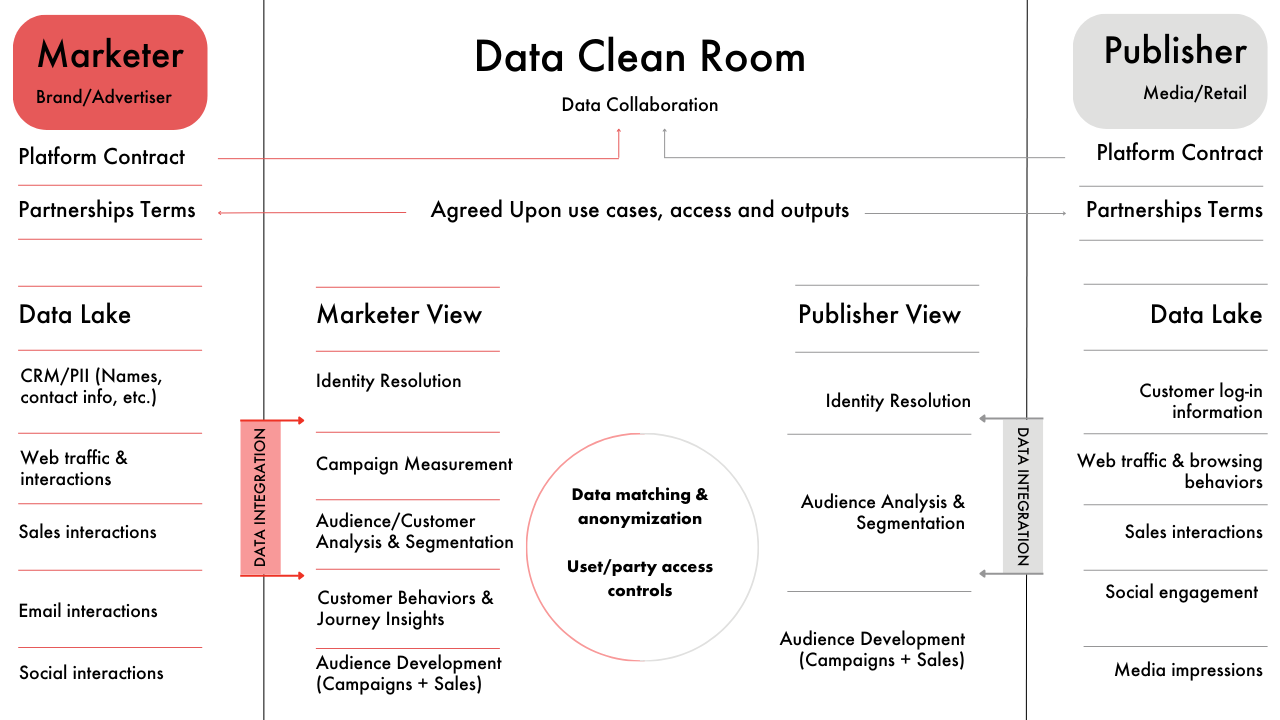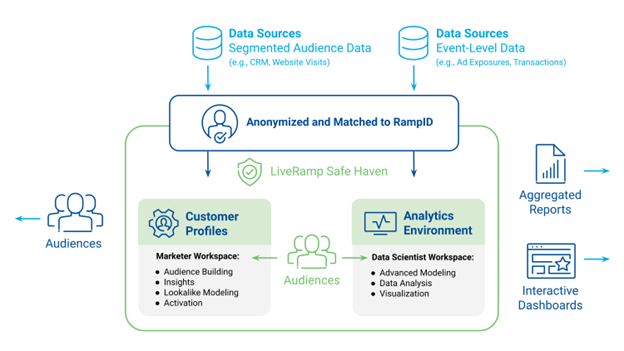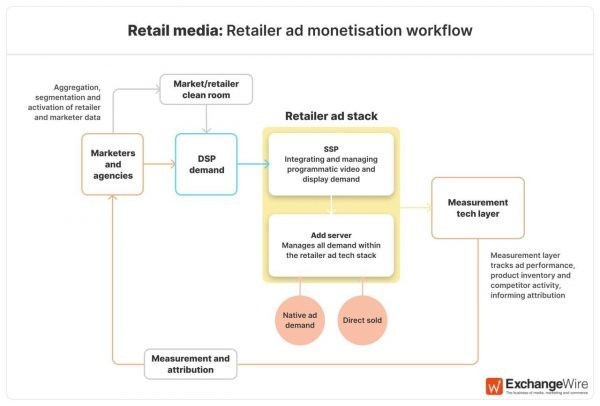Two-thirds (64%) of companies leveraging privacy preserving technology are using Data Clean Rooms. Data clean rooms are enabling data collaboration for retailers and brands in several ways. Here’s a rundown of the benefits and process for setting up a data clean room, as well as some examples of use cases and case studies.
A data clean room is a secure collaboration environment which allows two or more participants to leverage data assets for specific, mutually agreed upon uses, while guaranteeing enforcement of strict data access limitations, e.g., not revealing or exposing the personal data of their customers to other parties.
Retail media networks use data clean rooms to share anonymized and aggregated shopper data with brands and advertisers, within a secure environment, where retailers and advertisers can collaborate on data to improve targeting, advertising performance, and closed-loop measurement.

Use Cases for Retail Media Networks’ Data Clean Rooms
- Relevant marketing and advertising: By securely sharing anonymized customer data, retailers and brands can collaborate to deliver relevant advertisements to customers. For example, if a customer frequently purchases a particular type of product, a retailer could leverage their data to enable them to serve ads featuring complementary brands, products or promotions.
- Audience segmentation: Data clean rooms allow retailers and brands to work together to create and target high-value customer segments. By analyzing anonymized purchase history and browsing behavior, they can identify patterns and preferences that define various audience segments, such as “value-conscious shoppers,” “frequent buyers,” or “brand loyalists.”
- Attribution modeling: Retailers and brands can use data clean rooms to measure the impact of marketing campaigns on sales performance. By securely sharing anonymized transaction data, they can attribute specific marketing touchpoints to conversions and provide return on ad spend (ROAS).
- Inventory management and demand forecasting: Brands can leverage a retailer’s data clean rooms to gain insights into inventory levels and sales trends. This information can help them better forecast demand, optimize inventory management, and reduce out-of-stock situations.
“As Retail Media Networks mature, data collaboration with brand suppliers provides the opportunity to unlock improved campaign performance and consumer insights. Collaboration can unlock stronger partnership between brands and retailers but the process needs to be grounded in privacy and security with controls and permissioning built into the model.” – Lori (O’Neal) Johnshoy, Head of Global Retail, Media Network & CPG Industry Srategy, LiveRamp
In summary, data clean rooms can provide a secure environment for brands to collaborate on data with retailers and improve targeting, advertising performance, and closed-loop measurement. Brands can tap into these data clean rooms to enrich their own first-party data, target specific audience segments, and measure the impact of their advertising campaigns.
Benefits of Data Clean Rooms for Retailers and Brands
- Secure sharing: Retailers and brands can collaborate on data without exposing personally identifiable information, layering on mechanisms to comply with data privacy regulations.
- Improved targeting: By combining first-party data, retailers and brands can refine or create custom audience segments for targeted marketing and advertising campaigns.
- Better customer insights: Data clean rooms allow retailers and brands to gain deeper insights into customer behavior and preferences, leading to improved customer engagement and loyalty.
- Increased revenue: Through data clean room collaboration, retailers and brands can drive more sales and revenue through more effective targeting and personalized marketing.
Process to Enable and Set Up a Data Clean Room
To get the most value out of your data clean room there are several best practices you can follow:
- Make sure your own data is properly organized. A data clean room won’t benefit you or your partners if you don’t have your own data properly categorized and stored. Having a high standard for the integrity of your data will help extract the most value from the clean room’s capabilities. Also, equally fundamental in organizing your data is working closely with your company’s privacy team to ensure your company’s privacy and security best practices are implemented.
- Make sure you have the right resources and staff. Setting up a clean room requires employees that are comfortable working with data and are familiar with privacy regulations, compliance and requirements. Technical resources such as a data engineer, data analysts or scientist can all ensure the data is organized and properly entered into the clean room.
- Identify the business use cases you’re hoping to solve with a clean room. Determine your short-term and long-term goals and develop experimental frameworks you can run to achieve quick wins with your data clean room. Being able to share data with partners safely and securely often helps to generate new benefits or insights that can’t be achieved without combining or making use of multiple datasets. Understanding the potential audience and what you want to gain will help decide which partner to work with.
- Find the right partner who can scale with you. Evaluate owners of the needed data for their willingness and their technical foundation to support a potential partnership. When sharing or accessing data, organizations need to be able to trust those they are interacting with and feel comfortable doing so. Align on the goals/purpose of data sharing and the key stakeholders that will drive the partnership.
- Set the rules and permissions you want to allow in the clean room. Establishing parameters between partners so each data owner has full transparency and control during collaboration.

How Data Clean Rooms Are Democratizing Data
Retailers can monetize their data and create revenue streams by leveraging a data clean room. This technology allows them to bundle their data and media together, increasing the value of their inventory and owned and operated operations. By allowing CPG brands to identify unique audiences and overlaps across the retailer’s properties, a clean room can help retailers improve yields on their existing inventory. Additionally, data clean rooms provide advanced audience building and measurement capabilities, which are attractive to CPG brands for audience extension purposes. Overall, leveraging a data clean room can help retailers generate incremental high-margin revenue streams and improve the value of their data sets.
Carrefour’s partnership with LiveRamp involves using a data clean room to analyze consumer buying patterns, such as diaper purchases, without risking data leakage. According to LiveRamp, their technology queries siloed data sets in separate cloud environments, unveiling insights like brand switching as babies grow. Carrefour foresees significant growth potential, initially providing insights and measurement to advertisers before progressing toward a comprehensive approach to category management. This integration will provide a holistic view online advertising and shopper marketing, simplifying budget consolidation for CPG advertisers.
Criteo is a trusted partner for managing shopping and transactional data for top global retailers today. Through its Commerce Media Platform, Criteo provides value to the broader ecosystem by making retailer data easily accessible, actionable and normalized. By partnering with data clean rooms, Criteo can facilitate secure data sharing in a privacy-safe way to create a deeper and more complete view of the consumer journey, enabling brands to deliver relevant ads and promotions and ultimately drive commerce outcomes. For example, a brand that is running a retail media campaign and has its own direct to consumer site can understand the effect retail media spend has on channel performance by easily connecting their own conversion data within a data clean room, and then adjust their channel strategy accordingly.
The Trade Desk empowers retailers to own, manage, and monetize their first-party data by integrating with top Clean Rooms globally so retailers can securely send their first-party data into The Trade Desk’s media buying platform. This enables advertisers to use The Trade Desk to activate retail data to reach their target audience at scale and connect their digital campaigns to online and in-store sales.
For example, a retailer can push their first-party data to The Trade Desk via a data clean room integration for secure sharing and activation. Then, a beverage brand looking to drive sales of their new product can use that retailer’s audience segments to reach buyers who have purchased in their category but not their brand in order to grow market share. They can then use measurement from the retailer to connect those digital touchpoints to online and in stores. said Bene Lochtenberg, Senior Product Manager at The Trade Desk
These are just a few examples of retailers that are using data clean rooms to collaborate on data with their brand partners in a secure and compliant manner. By using data clean rooms, brands and advertisers are able to gain insights into customer behavior and preferences, improve targeting and customer engagement, and drive revenue growth.
Overall, data clean rooms provide a secure and privacy-first environment for retailers and brands to collaborate on data, leading to improved targeting, customer insights, and revenue.

https://www.exchangewire.com/blog/2022/05/05/retail-media-the-retailer-gameplan/
Colgate-Palmolive is utilizing clean data rooms as part of its digital transformation strategy. The purpose of these rooms is to improve the quality and security of the company’s data. By ensuring that the data is accurate and consistent, Colgate-Palmolive can make better decisions and respond more quickly to changes in the market. The clean data rooms will also help to safeguard the company’s data from potential security breaches or other threats. Overall, this initiative is aimed at enhancing the efficiency and effectiveness of the company’s operations through the use of high-quality data.
What Privacy Controls do Data Clean Rooms Offer?
Data clean rooms let users—be they marketers, agencies, or publishers, work with customer data at the individual customer level in a privacy—centric way by incorporating data assets that come through the collaboration with specific partners. Data Clean rooms minimize data movement and data duplication, allowing data owners to maintain a single source of truth, ideally from a single place consented and authenticated user level data, and to ensure those preferences are continuously updated and respected in how their data is accessed by other partners in the ecosystem.
An effective data clean room should balance the privacy needs of the supply side (data owners) and the utility needs of the demand side (data consumers). Regardless of which side you’re on, it’s important to have a platform that is flexible enough to meet the needs of all partners. A data clean room that only works for your needs, but not those of the other side, may not be adopted by the partners you’re looking to collaborate with.
Data clean rooms alone may not ensure compliance with data regulations, as they do not address the issue of obtaining and managing consent from individuals whose data is being shared. Consent management is a crucial aspect of data privacy regulations such as GDPR and CCPA, which require that individuals are informed about how their data will be used and give their explicit consent for such use. In the context of a data clean room, retailers and brands would need to obtain consent from individuals for their data to be shared and ensure that consent is managed properly throughout the data-sharing process.
In addition, establishing clear data sharing agreements with partners, outlining the terms and conditions for data access, usage, and protection within the data clean room. This will ensure that all parties are aligned and committed to the clean room’s objectives and privacy requirements.
For more information on Data Clean Rooms please visit Data Clean Rooms: Guidance and Recommended Practices, which establishes common principles, functions, privacy enhancing technologies for Data Clean Rooms and outlines some limitations and guardrails when engaging with DCR. Currently in its draft form for public comment.



